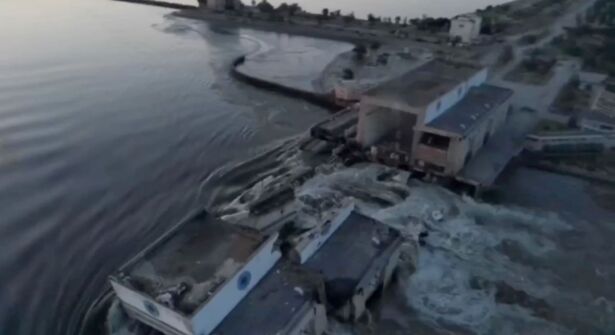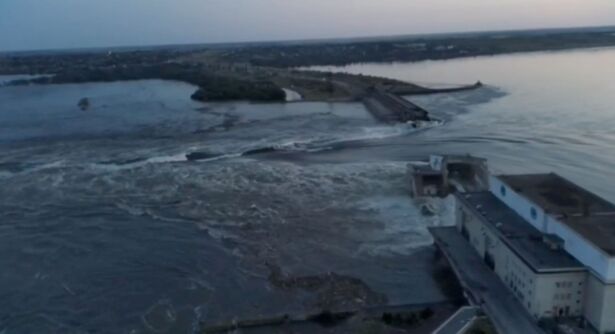Ukraine has blamed Russian forces for blowing up the dam of the Kakhovka Hydroelectric Power Plant on the Dnipro River in Russian-occupied southern Ukraine.
The Nova Kakhovka dam—which holds the same amount of water as the Great Salt Lake in the U.S. state of Utah—was destroyed in the early hours of June 6, sending millions of liters of water bursting through a gaping hole.
The damage has prompted mass evacuations of multiple villages alongside the bank of the river, including parts of Kherson, with fears of widespread flooding amid rapidly rising water levels.
Ukraine’s Southern Operational Command claimed in a Facebook post that Russian forces blew up the dam but said it was still assessing the situation.
“The Kakhovka [reservoir] was blown up by the Russian occupying forces,” it said. “The scale of the destruction, the speed and volumes of water, and the likely areas of inundation are being clarified.”
On Twitter, Ukrainian President Volodymyr Zelenskyy blamed “Russian terrorists” for the destruction of the dam, adding that it “only confirms for the whole world that they must be expelled from every corner of Ukrainian land.”
“Not a single meter should be left to them, because they use every meter for terror. It’s only Ukraine’s victory that will return security. And this victory will come. The terrorists will not be able to stop Ukraine with water, missiles or anything else,” the Ukrainian leader wrote.

‘Colossal Damage’ to Environment
Zelenskyy added that services are continuing as normal and that he has convened the National Security and Defense Council to discuss the issue.
Video footage shared by Zelenskyy showed vast amounts of water surging through the remains of the dam downstream while widespread destruction could be seen on either side of the gaping hole.
“The purpose is obvious: to create insurmountable obstacles on the way of the advancing [Ukrainian army] … to intercept the information initiative; to slow down the fair final of the war,” a Ukrainian presidential adviser, Mikhailo Podolyak, said on Twitter. “On a vast territory, all life will be destroyed; many settlements will be ruined; colossal damage will be done to the environment.”
“Russia must be immediately recognized as a terrorist country with all tough legal consequences,” Podolyak added.
European Council President Charles Michel also appeared to blame Russian troops for the “unprecedented attack” on the dam, writing on Twitter that the “destruction of civilian infrastructure clearly qualifies as a war crime – and we will hold Russia and its proxies accountable.”
According to the Geneva Conventions, attacking “works and installations containing dangerous forces, namely dams, dykes and nuclear electrical generating stations” can be considered a war crime if it “may cause the release of dangerous forces and consequent severe losses among the civilian population.”
Russian officials immediately countered the claims made by Ukraine and blamed the incident on Ukrainian military strikes in the contested area that destroyed the hydraulic valves of the hydroelectric power station.
The Russian-installed mayor of Nova Kakhovka, Vladimir Leontyev, said the damage to the Soviet-era dam was a result of overnight strikes by Ukraine’s armed forces and called it a “very serious terrorist act,” The Associated Press reported.

Evacuations Underway, ‘Critical’ Water Levels
Separately, Leontyev told local TV stations that residents from roughly 300 homes were being evacuated in order to avoid casualties as water levels were expected to rise rapidly. He claimed that the city was still being shelled by Ukrainian forces as of Tuesday morning.
He added that the scale of destruction is “very serious,” and that it is unclear how difficult it will be to restore the broken dam.
Ukraine’s state-owned energy company, Ukrhydroenergo, said in a separate statement that the damage caused by the breach will be “impossible to repair.” It added that water levels would reach “critical levels” within hours.
Water levels at the Kakhovka reservoir had already reached a 30-year high of 17.5 meters in recent months, according to official data.
Kherson Oblast Gov. Oleksandr Prokudin said on national television that roughly 16,000 homes in the area are located in “critical risk” zones and are currently being evacuated. The villages of Tiahynka, Lvove, Odradokamianka, Ivanivka, Mykilske, Poniativka, Tokarivka, Bilozerka, and the Ostrov district in Kherson were “fully or partially flooded,” Prokudin said.
Initially built in 1956 on the Dnipro River as part of the Kakhovka Hydroelectric Power Plant, the Nova Kakhovka dam is 30 meters (33 yards) tall and 3.2 kilometers (2 miles) long.
The dam supplies water to southern Ukraine and the Crimean peninsula, which was annexed by Russia in 2014, and also to the Zaporizhzhia nuclear plant, which is also under Russian control.
The International Atomic Energy Agency said on Twitter that it was aware of reports regarding damage to the dam but that there is no immediate nuclear safety risk at the Zaporizhzhia nuclear plant. Officials are closely mentoring the situation, the agency added.
Reuters contributed to this report.
From The Epoch Times

